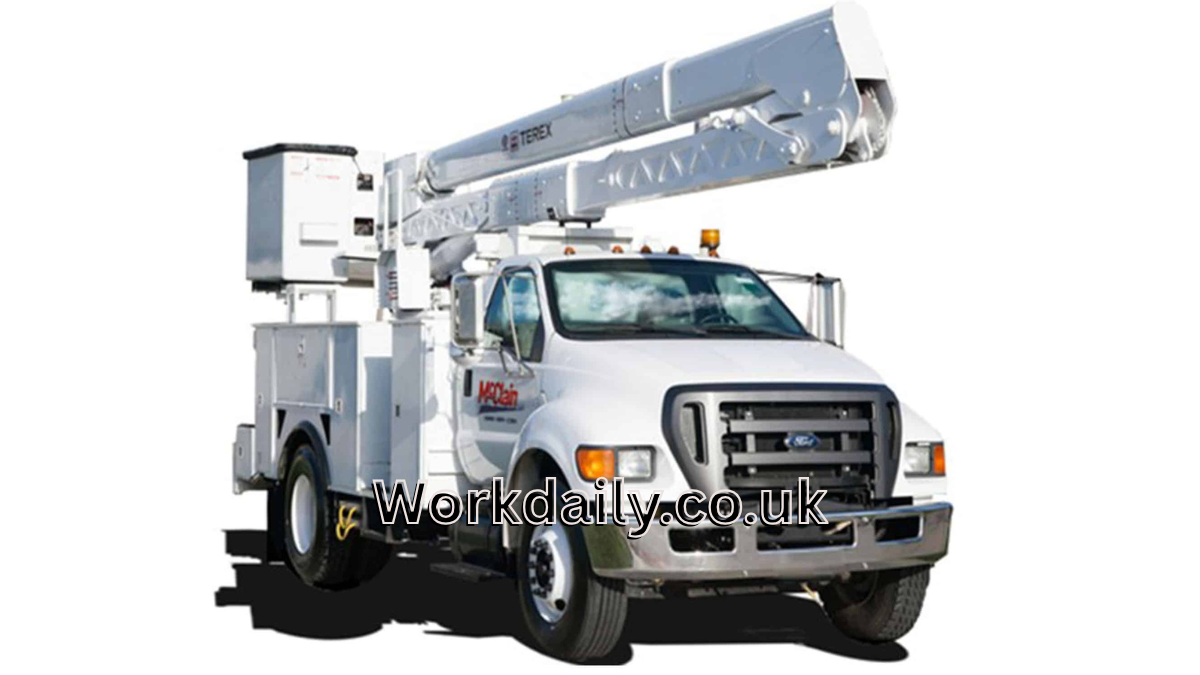The modern urban and suburban landscape is a complex Bucket Trucks tapestry of utility lines, towering signage, and meticulously maintained foliage, much of which exists far above human reach. When a power line needs repair, a towering elm requires pruning, or a street light fails, the task calls for more than a ladder; it demands the specialized capability of the bucket truck. Also known as an aerial work platform (AWP) or a cherry picker, this indispensable piece of heavy machinery has revolutionized elevated work, moving it from a risky, unstable endeavor to a safe, highly efficient, and regulated industry standard. The bucket truck is essentially a heavy duty vehicle equipped with a hydraulic or electrically powered telescoping or articulated boom that terminates in a fiberglass or metal platform the “bucket” designed to safely hoist workers and their tools to significant heights. This innovation has fundamentally changed industries ranging from utility and telecommunications to arboriculture, enabling professionals to execute precision tasks at elevation with unprecedented safety and speed.
Before the widespread adoption of the modern hydraulic lift, high altitude work often relied on precarious scaffolding, cumbersome hoists, or dangerous ladder setups, greatly increasing the risk of falls, electrocution, and structural accidents. The bucket truck provides a stable, insulated, and mobile workspace, drastically mitigating these risks. Its invention transformed the efficiency of critical infrastructure maintenance; a task that once took hours to set up can now be accomplished in minutes. This comprehensive guide serves as an authoritative resource for understanding these machines, covering everything from the critical safety protocols that govern their use to the technical criteria involved in selecting and maintaining the perfect model for specific operational demands. Our goal is to equip operators, fleet managers, and business owners with the knowledge required to utilize these powerful assets effectively, ensuring compliance, longevity, and, above all else, the unwavering safety of the personnel who depend on them every day.
Understanding Bucket Trucks: Types, Components, and Applications
Core Types and Key Terminology
Bucket trucks come in various configurations, each designed to meet unique job site challenges. The primary differentiation lies in the boom mechanism. Telescopic booms extend in a straight line, offering the maximum possible vertical reach and are ideal for jobs requiring simple, direct access, such as inspecting bridges or working directly over utility lines where no obstacles intervene. In contrast, articulating booms, also known as knuckle booms, consist of multiple hinged sections that allow the operator to reach up, over, and around existing obstacles, making them invaluable in congested areas, cityscapes, or densely branched trees. Many modern trucks feature a Telescopic/Articulating Combo to provide the ultimate in operational flexibility. A crucial distinction, particularly for those in the electrical utility sector, is between insulated (dielectric) and non insulated bucket Trucks. Insulated bucket Trucks utilize non conductive materials and design to protect workers from electrical contact, adhering to stringent standards that classify their protection levels (e.g., Category C, B, or A).
Understanding the nomenclature is key to safe operation. The boom is the main lifting arm, responsible for the truck’s reach and height. The bucket Trucks or platform is the worker’s secure enclosure. Safety on the ground is primarily maintained by the outriggers or stabilizers, which are hydraulic legs that extend outward to level the vehicle and distribute its weight, preventing tipping when the boom is extended. The machine’s capabilities are measured by its working height (the maximum height the floor of the bucket Trucks can reach, plus an allowance for the worker’s height) and its platform capacity, the maximum weight the bucket Trucks can safely bear, including the worker, tools, and materials. Operators must become intimately familiar with these terms and the specific ratings of their equipment to prevent catastrophic overloading and ensure operational stability.
Primary Industry Applications
The versatility of the bucket truck has made it a cornerstone across numerous essential industries. In Utility & Telecommunications, these trucks are non negotiable, providing safe access for line repair, installation of fiber optic cables, transformer maintenance, and routine pole inspections. Without them, maintaining the power grid and communication infrastructure would be exponentially more dangerous and slower. Arboriculture (Tree Care) relies heavily on bucket trucks for precision pruning, trimming, and even the removal of hazardous limbs near structures or power lines. The reach and stability allow arborists to work safely within a tree’s canopy without resorting to precarious climbing methods.
Beyond utilities and trees, the demand for aerial access extends to public and commercial infrastructure. Lighting Maintenance crews use bucket trucks daily to service high mounted fixtures like streetlights, traffic signals, and large format commercial signage, reducing downtime and ensuring public safety. In Construction & Signage applications, they are used for installing massive billboards, performing facade work on multi story buildings, and even bridge inspection. Essentially, any professional task that requires a safe, temporary, mobile, and elevated workspace where a traditional lift or scaffolding is impractical falls under the domain of the adaptable and robust bucket truck.
Safety First: Essential Protocols for Bucket Truck Operation
Pre Operation Inspection and Checklist
Safety in bucket truck operation is not a feature; it is a discipline, beginning well before the engine is even started. Every shift must commence with a rigorous Pre Operation Inspection. This is a non negotiable, systematic check that covers both the vehicle and the lift mechanism. Operators must first perform a thorough Vehicle Inspection, verifying essential elements such as tire pressure, brake functionality, fluid levels, and the integrity of the chassis. A critical component is the Boom and Hydraulic Check, requiring close visual inspection for any signs of hydraulic leaks, worn hoses, cracks in the boom structure, or damage to the fiberglass bucket Trucks itself. All upper and lower Control Verification must be performed, ensuring that emergency stops and operational joysticks respond correctly before the platform is elevated. The most vital step preceding boom extension is the proper deployment of the Outriggers/Stabilizers. The ground must be assessed for stability soft soil may require the use of outrigger pads (cribbing) to properly distribute the load and the vehicle must be leveled within manufacturer specifications to guarantee stability at full extension. Skipping or rushing this checklist is the leading cause of accidents, transforming a safety machine into a profound hazard.
Workplace Hazard Assessment and Safe Operating Procedures
Once the machine is cleared for operation, the focus shifts to the dynamic environment of the job site. The most significant and potentially fatal hazard is proximity to Power Lines. Every operator must adhere strictly to the Minimum Approach Distance (MAD), a regulated safety zone that prohibits the bucket Trucks, boom, or any part of the worker from entering specified distances from energized lines, a distance that varies based on voltage. Weather Conditions must also be monitored continuously; bucket trucks have defined operational limits for wind speed, and operation must cease immediately during lightning activity or heavy precipitation that compromises visibility or stability. Ground Conditions must be re evaluated for stability, especially on sloped or uneven terrain, which demands more aggressive stabilization. Safe operation also necessitates strict adherence to machine limits: Never Exceed Load Capacity is paramount. Furthermore, prohibited actions like sitting or standing on the platform rail, using the boom to push or pull heavy loads, or attempting to move the truck while the boom is extended (known as “booming up and driving”) are all grounds for immediate cessation of work, as they introduce destabilizing forces that can cause the truck to tip or fail structurally.
Selection, Purchasing, and Maintenance
Choosing the Right Bucket Truck for Your Needs
Selecting the correct bucket truck is a major capital decision that dictates the efficiency and safety of a company’s operations for years. The selection process must be based on a cold analysis of a business’s most frequent needs, prioritizing Working Height and Horizontal Reach based on the typical job profile. A sign installer needs horizontal reach to get over setbacks, while a utility crew needs maximum vertical height. Platform Capacity must comfortably accommodate the crew, their tools, and the heaviest material (e.g., a transformer or heavy cabling) they routinely lift. For any electrical work, the Dielectric Rating is non negotiable; insulated units are mandatory and must meet strict ANSI standards. Finally, the Chassis Requirements the specific truck onto which the boom is mounted must be considered. This includes the Gross Vehicle Weight Rating (GVWR) to handle the boom’s weight, the turning radius for maneuverability in urban settings, and the required engine power to handle heavy loads and steep grades. A thorough assessment prevents the costly mistake of buying a machine that is either underpowered or incapable of reaching the most common work zones.
Preventative Maintenance and Longevity
A bucket truck is a complex hydraulic and mechanical system, and its longevity and reliability are directly tied to a rigorous Preventative Maintenance schedule. Unlike standard commercial vehicles, bucket trucks require specialized maintenance centered on the lift mechanism. Routine Hydraulic System Checks are vital, including regular monitoring of fluid levels, filter changes, and immediate replacement of worn or leaking hoses. The integrity of the boom structure itself is confirmed through Structural Integrity checks, which often include mandatory annual or bi annual Non Destructive Testing (NDT), such as magnetic particle or ultrasonic inspection, to detect microscopic stress cracks that could lead to catastrophic failure. Operator Daily Checks serve as the first line of defense, catching minor issues like low fluid levels or loose bolts before they escalate. Adhering to manufacturer recommended lubrication schedules for all pins, bearings, and hydraulic cylinders minimizes wear. By treating maintenance not as an expense but as a mandatory safety investment, companies can maximize the operational lifespan of their valuable assets, ensure regulatory compliance, and, most importantly, protect their employees.
Conclusion
The bucket truck is an engineering marvel that has successfully merged the mobility of a vehicle with the precision of a controlled lift, transforming high altitude work into a standardized, reliable operation. From the critical maintenance of power grids to the detailed work of urban arborists, this machine enables industries to function efficiently and safely. The takeaways from this guide are clear: safety is paramount, beginning with the meticulous pre operation inspection and extending through strict adherence to hazard assessments, especially concerning power lines and weather. Selection requires careful matching of the truck’s reach and capacity to the job profile, while longevity is secured through uncompromising preventative maintenance. By committing to comprehensive operator training and rigorous compliance with safety protocols, companies not only protect their most valuable assets their people but also guarantee the operational excellence that is the hallmark of professional elevated work. The journey to the top is safe only when the foundation is sound




